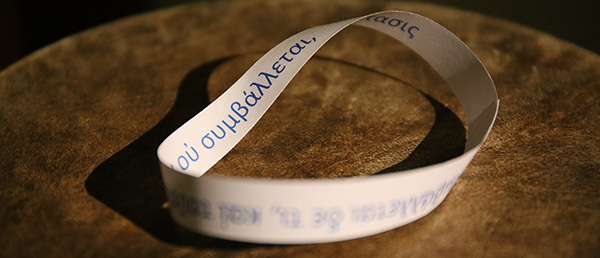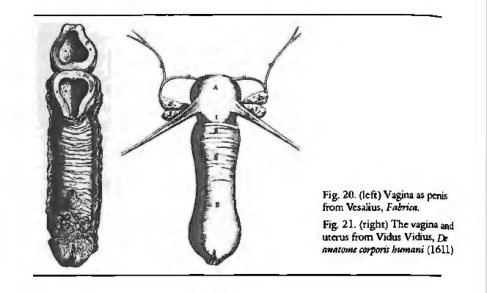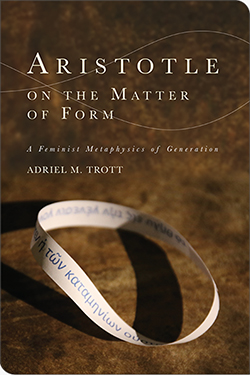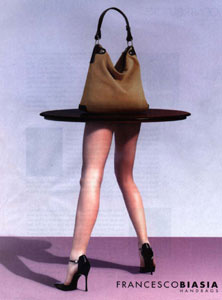

Even as strides toward gender equality have been made in the last century, the notion that gender is a binary divided between those who determine the social world – men – and those who need to be determined – women – remains well entrenched. Advertisements depict women as furniture, food and body parts. Assumptions that men are more rational and capable of being brilliant and women emotional and constrained by their bodies continue to affect elections, hiring practices and career advancement, in for example, the academy. But did you know that these ideas can be traced back to Aristotle? Aristotle saw gender – the opposition between men and women, male and female – as associated with an opposition between form and matter. Form and soul give shape to the world. Matter and body are the stuff that needs to be shaped and properly bounded.
Male and female, matter and form
Aristotle describes generation as a process in which the male contributes form – the animating force of soul – through semen, while the female contributes material as menses. These have been taken to be contrary contributions, where the male offers what the female lacks. But is matter what has no power or definition of its own and form wholly independent of matter in generation? Aristotle repeatedly describes semen as working through the material that comprises it – water and hot air. They make it into a kind of foam through vital heat, a heat that is internal to semen and makes it capable of heating the menses to the point where the internal heat is in the menses: that is the moment when the foetus forms. Moreover, both the menses and semen develop out of the same process of heating blood, only the semen is heated to the point where it becomes self-heating.
If you think of form in Aristotle as some shape that exists separately from the individuals who embody the form, then you might think that semen is just the carrier of some immaterial force. But if you think that form as soul directly causes each individual, unifying and animating it, and that it has to do that in some way that is immanent to it rather than externally imposed, as I think makes the most sense of Aristotle’s physics and metaphysics, then you can accept Aristotle’s repeated reference to the material that constitutes semen as what animates. It is true that Aristotle says that the semen contributes no material, but he doesn’t say that the semen can’t be working through and as the material that makes it what it is.
Aristotle’s account of matter
Many people have understood Aristotle’s account of matter as ‘prime matter’ or matter that has no character. But Aristotle’s account of matter existing in the world, the smallest building blocks in nature, are not only of elements – water, air, fire, and earth – but of the elemental forces that constitute the elements – heat and cold, dry and wet. Elements change into one another by exchanging elemental forces, as fire changes from being hot and dry to air by exchanging dry for wet. Thus the basic forces that constitute semen as material have power in themselves not just by being shaped by form.
Describing sexual difference
Historians of sex describe two models of how people think about sexual difference: the one-sex model and the two-sex model. The one-sex model defines sex as male and the female as the inverted male. This model involves fluidity because the activity and circumstances of the male or female does is what defines them as male or female (in this way, the one-sex model views sex more like what we talk about gender today). However, the problem with this model is that it makes the male the measure, and female defined by lack or distance from the male measure. The two-sex model instead defines male and female as different essences with different roles and different organs. This model would appear to treat the female on her own terms, but results in making the female solely defined by her womb.
Aristotle and gender: one sex or two?

Scholars have had a hard time deciding into which model Aristotle fits. He seems to fit the two-sex model, since form and matter are distinct principles and male is associated with form and female with matter. But Aristotle also describes the difference between the male and female contribution as a matter of degrees and shows how the male contribution can act in a way that seems to fail and thus to appear to be more like the female contribution. When this is the case, the relation between form and matter seems to be one of capacity and lack of it. In fact, some people seem to understand the relation of the two principles of form and matter in just that way. If you define the difference between male and female in terms of a one-sex model then you are saying the difference is a material one, and thus not a real difference, because only form is supposed to mark distinction. But if you take the difference between male and female to be on the two-sex model, then you take the difference to be a formal one, but then these differences of degree cannot be accounted for. This dilemma follows if we see form itself as having to be wholly other, and then, the measure the distance from which matter is measured.
Form and matter for Aristotle and gender
I argue that while Aristotle’s account privileges form, form becomes form in semen through material work. Take a slip of paper that has two sides. The two sides might be considered opposed contraries. But if you turn the paper and connect it at the end, you can move from one side to the other. Such an image offers a way to think of form and material as doing different work but also interdependent. For me, this image captures Aristotle’s account of the relation of form and matter, male and female in generation.
How we think about the social world, including about sex and gender, is influenced by metaphysical frameworks that we might not even realise we have soaked up from the world like that of an opposition and hierarchy between form and matter. By reading Aristotle against the received reading, we can find different way of understanding form and matter and different models for thinking sex and gender as neither simple opposition and nor hierarchal binaries, but accounts that show a fluidity and an interdependence, like that Möbius strip.
By Adriel M. Trott

Adriel M. Trott is Associate Professor and Chair of Philosophy at Wabash College. She is interested in nature, gender, and political life in ancient philosophy.

In Aristotle on the Matter of Form: Α Feminist Metaphysics of Generation, Adriel M. Trott argues for a robust sense of matter in Aristotle in response to feminist critiques. She finds resources for thinking the female’s contribution – and the female – on its own terms and not as the contrary to form, or the male.
Image Credits
- Mobius strip photograph: Dany Naierman
- ‘Vagina-Vesalius’ by Andreas Vesalius from Thomas Laqueur, Making Sex, Harvard University Press, 1991
Want to find out more about Aristotle and gender? Try this further reading:
- For Women’s History Month, a look at gender gains – and gaps – in the US (article)
- Rationality is Gendered: Using Social Cognition to Explore the Thinking/Feeling Gender Bias (thesis)
- The Gender ADs Project: Woman as Object (website)
- It’s the Sexism, Stupid: Why men are dominating the Democratic 2020 primary (article)
- Sexism in the Academy: Women’s narrowing path to tenure (article)
- Making Sex: Body and Gender from the Greeks to Freud (book)









[…] first delve into Aristotle’s gender philosophy. According to Aristotle, gender is a dichotomy of form and matter, where men represent form and […]